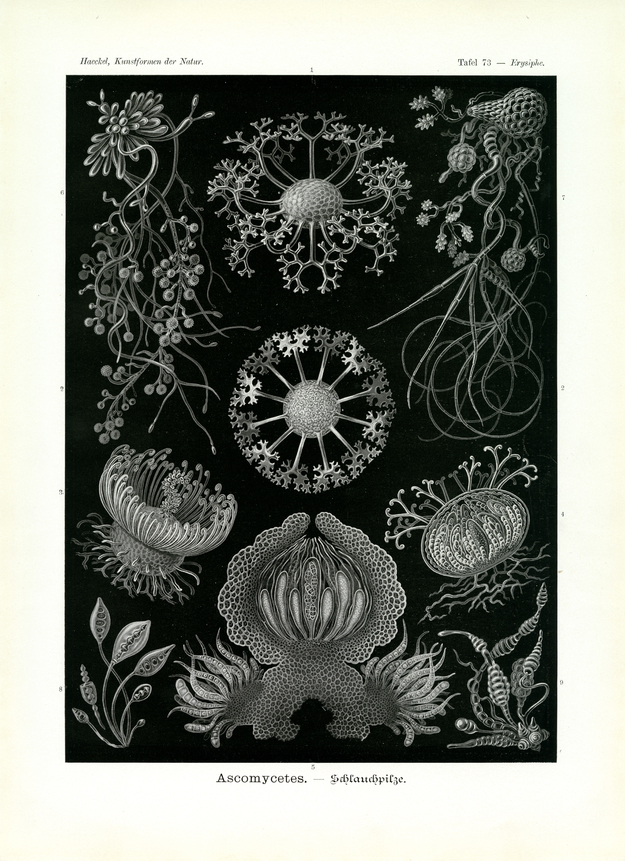The two major classes of fungi are distinguished by the fact that in ‘sponge fungi’ (Basimycetes, plate 63) the spores or generative cells are generated from the ‘mother-cell’ (Sporometra) through budding, freely resting on basidia, while in ‘tube-fungi’ (Ascomycetes) they have their origin in the division of a ‘spore-mother-cell’, embedded in ‘spore-tubes’ or Ascodia. The major part of Ascomycetes belongs to the legion of ‘fruit-capsule-fungi’ (Carpascodii); their ‘spore-tubes’ contain a limited number of spores (usually eight) and are encased in special fruiting bodies, capsule-shaped Ascothecia. Three orders with more than 10000 species belong to this legion; many of them are very small, many a times microscopically small; however, as parasites of plants they are most important, causing serious diseases.
The order of ‘mildew-fungi’ (Capnomycetes or Perisporiales) is distinguished by completely closed ‘fruit capsules’ (Clistothecia); the encased spores are released with the decomposition of the cover. The mycelium of these harmful fungi (the vegetative mesh of articulated filaments, Hyphae) forms the whitish, cobweb-like coating on leaves and other green parts of plants, usually called mildew. The fruiting bodies (fig. 1-4), to the naked eye visible as small black dots, usually display most intricate forms. ‘Grape-fungus’ (Erysiphe Tuckeri) causing the serious grape disease, belongs here; but also common moulds (Penicillium, Eurotium).
The order of ‘pip-fungi’ (Pyrenomycetes or Peritheciales, fig. 5-9) has an opening at the crest of the fruit capsules (Perithecia) through which the spores advance. It does not reproduce by means of spores of which usually eight each are embedded within a ‘spore-tube’ (fig. 5), but through ‘dust-spores’ (Conisia or Conidia) that arise in indefinite number through budding from a ‘hypha-cell’, often in the shape of a rosary-like spore-string (Sporocatena, fig. 8 and 9). ‘Soot-dew-fungi’ belong here with their Mycelia covering green plants with a black crust. The order of ‘disc-fungi’ (Discomycetes or Apotheciales) is distinguished by open ‘fruit bodies’ (Apothecia) that resemble a disc or a dish. Eatable morels (Morchella), helvels (Helvella) and ‘cup-fungi’ (Peziza) belong here.
Translation of the original German introduction by Ernst Haeckel:
Phylum of Fungi or Mycetes (Pilze); - class of Ascomycetes or Ascodiomycetes (Schlauchpilze); -legion of Carpascodii (Fruchtkapselpilze).
Translation by VR Translators Bangalore
This is one of the 100 pop science biology illustrations that were published from 1899 – 1904 in Leipzig by Ernst Haeckel through Verlag des Bibliographischen Instituts.
We've scanned the original lithography at 1200dpi on the Epson A3 scanner of A3 scanner huren. You can download a 400dpi JPEG here.
